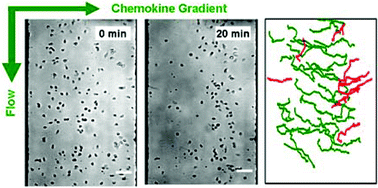T cell chemotaxis in a simple microfluidic device
Abstract
This paper describes the use of a simple microfluidic device for studying T cell chemotaxis. The microfluidic device is fabricated in poly(dimethylsiloxane) (PDMS) using soft-

a
Laboratory of Immunology and Vascular Biology, Department of Pathology, School of Medicine, Stanford University, Stanford, California 94305, USA
E-mail:
ebutcher@stanford.edu
Fax: +1 650 858 3986
Tel: +1 650 852 3369
b Center for Molecular Biology and Medicine, Veterans Affairs Palo Alto Health Care System, Palo Alto, California 94304, USA
This paper describes the use of a simple microfluidic device for studying T cell chemotaxis. The microfluidic device is fabricated in poly(dimethylsiloxane) (PDMS) using soft-

 Please wait while we load your content...
Something went wrong. Try again?
Please wait while we load your content...
Something went wrong. Try again?
F. Lin and E. C. Butcher, Lab Chip, 2006, 6, 1462 DOI: 10.1039/B607071J
To request permission to reproduce material from this article, please go to the Copyright Clearance Center request page.
If you are an author contributing to an RSC publication, you do not need to request permission provided correct acknowledgement is given.
If you are the author of this article, you do not need to request permission to reproduce figures and diagrams provided correct acknowledgement is given. If you want to reproduce the whole article in a third-party publication (excluding your thesis/dissertation for which permission is not required) please go to the Copyright Clearance Center request page.
Read more about how to correctly acknowledge RSC content.
 Fetching data from CrossRef.
Fetching data from CrossRef.
This may take some time to load.
Loading related content
